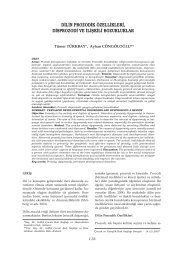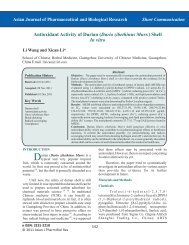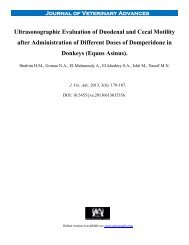Review of Piperine as a Bio-enhancer - eJManager.com
Review of Piperine as a Bio-enhancer - eJManager.com
Review of Piperine as a Bio-enhancer - eJManager.com
Create successful ePaper yourself
Turn your PDF publications into a flip-book with our unique Google optimized e-Paper software.
REVIEW ARTICLE Am. J. PharmTech Res. 2012; 2(2) ISSN: 2249-3387<br />
<strong>Review</strong> <strong>of</strong> <strong>Piperine</strong> <strong>as</strong> a <strong>Bio</strong>-<strong>enhancer</strong><br />
Acharya SG.*, Momin AH, Gajjar AV.<br />
1. K. B. Institute <strong>of</strong> Pharmaceutical Education and Research, Gandhinagar-382023<br />
ABSTRACT<br />
<strong>Piperine</strong> (1-peperoyl piperidine), a pungent alkaloid, is found in various Pipper species. <strong>Piperine</strong><br />
produces antioxidant, antiplatelet, anti-inflammatory, antihypertensive, hepatoprotective,<br />
antithyroid, antitumor, anti<strong>as</strong>thmatic activities and also a fertility <strong>enhancer</strong>. <strong>Piperine</strong> enhances<br />
absorption from g<strong>as</strong>trointestinal tract by various mechanisms and reduces gut metabolism <strong>of</strong><br />
drugs. <strong>Piperine</strong> modulates membrane dynamics and lipid environment and incre<strong>as</strong>es permeability<br />
at site <strong>of</strong> absorption Molecular structure <strong>of</strong> piperine is suitable for enzyme inhibition and it<br />
inhibits various metabolizing enzymes like cytochrome bs, NADPH cytochrome, CYP3A4,<br />
UDP-glucose dehydrogen<strong>as</strong>e (UDP-GDH), aryl hydrocarbon hydroxyl<strong>as</strong>e (AAH) and UDP-<br />
glucuronyl transfer<strong>as</strong>e. Structural modification <strong>of</strong> piperine provides selective inhibitors <strong>of</strong><br />
various cytochrome p450 enzymes. Inhibition <strong>of</strong> these enzymes by piperine results in enhanced<br />
bioavailability <strong>of</strong> drugs and nutrients like oxytetracyclin, metronidazole, ampicillin, norfloxacin,<br />
cipr<strong>of</strong>loxacin, acefotaxime, amoxicillin trihydrate, curcumin, beta-carotene, carbamazepine,<br />
gallic acid, nimesulide, tiferron, nevirapine, pentobarbitone, phenytoin, resveratrol, v<strong>as</strong>icine and<br />
sparteine by different mechanisms. Thus piperine is an absorption <strong>enhancer</strong> and a potent<br />
inhibitor <strong>of</strong> drug metabolism.<br />
Key words: <strong>Piperine</strong>, Metabolism inhibitor, Absorption <strong>enhancer</strong>, <strong>Bio</strong>-<strong>enhancer</strong>, bioavailability<br />
*Corresponding Author Email: swapnil_sadhu@yahoo.co.in<br />
Received 25 January 2012, Accepted 8 February 2012<br />
Journal home page: http://www.ajptr.<strong>com</strong>/<br />
Ple<strong>as</strong>e cite this article in press <strong>as</strong>: Acharya SG et al., <strong>Review</strong> <strong>of</strong> <strong>Piperine</strong> <strong>as</strong> A <strong>Bio</strong>-Enhancer . American<br />
Journal <strong>of</strong> PharmTech Research 2012.
Acharya et al., American Journal <strong>of</strong> PharmTech Research. 2012; 2(2) ISSN: 2249-3387<br />
INTRODUCTION<br />
<strong>Piperine</strong> (1-peperoyl piperidine), a pungent alkaloid, is found in Pipper nigrum, Pipper longum,<br />
Pipper retr<strong>of</strong>ractum, Pipper crussi and Pipper geniculatum 1 . <strong>Piperine</strong> is solid having molecular<br />
formula C17H19O3N, melting point 128°C and it is optically inactive, sparingly soluble in water<br />
with cis-trans isomerism. It h<strong>as</strong> been used <strong>as</strong> a flavoring additive in brandy and <strong>as</strong> an insecticide<br />
for houseflies 2 . It is a weak b<strong>as</strong>e, highly lipophilic and exhibits non-saturable p<strong>as</strong>sive absorption<br />
kinetics with short absorption clearance and high apparent permeability co-efficient. Long<br />
pepper (Piper longum) is widely used in the Indian System <strong>of</strong> Medicine (Ayurvedic System)<br />
along with black piper and ginger to enhance the therapeutic efficacy <strong>of</strong> the concurrently<br />
administered drugs 3 . <strong>Piperine</strong> is found to be a bioavailable agent 4 produced antidepressant effect<br />
on mice 5 and antidepressant and cognitive enhancing effect on wistar male rats 6 . <strong>Piperine</strong><br />
protected cisplatin-induced apoptosis through the induction <strong>of</strong> heme oxygen<strong>as</strong>e-1 expression 7 .<br />
<strong>Piperine</strong> also produces Antioxidant 8 , Anti-platelet 9 , Anti-inflammatory 10 , Antihypertensive 11 ,<br />
Hepatoprotective 12 , Antithyroid 8 , Antitumor 13 , Anti<strong>as</strong>thmatic 14 activities and found to be<br />
Fertility Enhancer 15 . <strong>Bio</strong>availability is affected by g<strong>as</strong>tric emptying time, intestinal transit time,<br />
blood flow through GIT, g<strong>as</strong>trointestinal contents and pre-systemic metabolism through luminal<br />
enzymes, gut wall enzymes, bacterial enzymes, and hepatic enzymes 16 . Some drugs show poor<br />
oral bioavailability because a drug must not only penetrate the intestinal mucosa, it must also run<br />
the gauntlet <strong>of</strong> enzymes that may inactivate it in gut wall and liver. <strong>Bio</strong>availability means the<br />
fraction <strong>of</strong> an orally administered dose that reaches the systemic circulation <strong>as</strong> intact drug, taking<br />
into account both absorption and local metabolic degradation 17 . <strong>Piperine</strong> enhanced oral<br />
bioavailability <strong>of</strong> various drugs and nutrients, which provides b<strong>as</strong>is for piperine to be a bio-<br />
<strong>enhancer</strong><br />
<strong>Piperine</strong> <strong>as</strong> Absorption Enhancer<br />
In vivo piperine incre<strong>as</strong>ed fluidity <strong>of</strong> intestinal brush border membrane (BBM), at 5, 10, 20<br />
mg/kg body weight within 5-15 min <strong>of</strong> administration and also supported by in vitro studies.<br />
<strong>Piperine</strong> incre<strong>as</strong>ed micro villi length in time dependent manner up to 2 h after in vivo treatment,<br />
which incre<strong>as</strong>es the absorptive surface <strong>of</strong> small intestine. <strong>Piperine</strong> induced incre<strong>as</strong>e in ribosome<br />
in free cytopl<strong>as</strong>m and on endopl<strong>as</strong>mic reticulum, which promotes mRNA translation and<br />
synthesis <strong>of</strong> extracellular and cytosolic proteins. <strong>Piperine</strong> induces synthesis <strong>of</strong> proteins <strong>as</strong>sociated<br />
with cytoskeletal function, resulting in incre<strong>as</strong>ed absorptive surface <strong>of</strong> small intestine and thus<br />
<strong>as</strong>sisting permeation through the epithelial barrier. <strong>Piperine</strong> could modulate membrane dynamics<br />
33 www.ajptr.<strong>com</strong>
Acharya et al., American Journal <strong>of</strong> PharmTech Research. 2012; 2(2) ISSN: 2249-3387<br />
and permeation characteristics by interacting with lipids and hydrophobic proteins. This may<br />
decre<strong>as</strong>e the tendency <strong>of</strong> membrane lipids to act <strong>as</strong> steric constraints 18 . A polar piperine<br />
molecule absorbed very f<strong>as</strong>t across the intestinal barrier and form a polar <strong>com</strong>plex with drug and<br />
solutes 2 . <strong>Piperine</strong> altered membrane dynamics and permeation characteristics <strong>of</strong> stratum<br />
corneum by lipid extraction and interaction with keratin, resulted in incre<strong>as</strong>ed permeation across<br />
human epidermal membrane. <strong>Piperine</strong> enhanced transdermal permeation/absorption <strong>of</strong><br />
Acecl<strong>of</strong>enac by same mechanism 19 . <strong>Piperine</strong> w<strong>as</strong> found to inhibit g<strong>as</strong>tric emptying (GE) <strong>of</strong><br />
solid/liquid in rats and g<strong>as</strong>trointestinal transit (GT) in mice in a dose and time dependent manner<br />
20 . In vitro piperine significantly stimulated γ-glutamyl transpeptid<strong>as</strong>e (γ-GT), enhanced the<br />
uptake <strong>of</strong> radiolablled L-lucine, L-isolucine and L valine and incre<strong>as</strong>ed lipid peroxidation in<br />
freshly isolated epithelial cells <strong>of</strong> rat jejunum. <strong>Piperine</strong> may interact with lipid environment to<br />
incre<strong>as</strong>e permeability <strong>of</strong> intestinal cells 21 .<br />
Metabolism Inhibition<br />
<strong>Piperine</strong> inhibited CYP450, cytochrome bs and NADPH cytochrome C reduct<strong>as</strong>e 22 . and major<br />
metabolizing enzyme CYP3A4, which is responsible for the first p<strong>as</strong>s metabolism <strong>of</strong> drugs 23 . It<br />
is a non-specific inhibitor <strong>of</strong> drug metabolism which shows little discrimination between<br />
different CYP P450 forms 24 and found to inhibit rat CYP4502B1 which convert aflatoxin B1 to<br />
cytotoxic and genotoxic metabolite. Thus piperine incre<strong>as</strong>e bioavailability <strong>of</strong> parent aflatoxin B1<br />
and produce chemoprotective effect against procarcinogens activated by CYP4502B1 25 .<br />
Structure <strong>of</strong> piperine is suitable for enzyme inhibition. Three <strong>com</strong>ponents <strong>of</strong> piperine<br />
methylenedioxyphenyl (MDP) ring, side chain and the piperidine moiety (Figure 1) together, are<br />
essential for maximal inhibition <strong>of</strong> both the constitutive and inducible arylhydrocarbon<br />
hydroxyl<strong>as</strong>e (AHH) and 7-methoxycoumarin-O-demethyl<strong>as</strong>e (MOCD) activities and the<br />
modification <strong>of</strong> any one moiety in the piperine molecule may not only alter the status <strong>of</strong><br />
inhibition but also could elicit differential inhibition <strong>of</strong> the two types <strong>of</strong> monooxygen<strong>as</strong>e<br />
activities. Saturation <strong>of</strong> the side chain <strong>of</strong> piperine induces flexibility in the molecule which may<br />
facilitate interaction <strong>of</strong> the inactivator with protein domain and may thereby enhance constraints<br />
for orientation <strong>of</strong> the CYP substrates to the active site. Saturation <strong>of</strong> the conjugated double bonds<br />
to tetrahydro-derivatives <strong>of</strong> MDP ring appear to result in higher flexibility <strong>of</strong> the side chain<br />
which perhaps acts <strong>as</strong> a handle to orient MDP group to the active site <strong>of</strong> the CYP450 anchored in<br />
a strong hydrophobic environment. Thus, altering the functional groups in piperine would<br />
determine its interaction with the hydrophobic environment <strong>of</strong> the active site and hence it’s<br />
potential to determine the specificity and extent <strong>of</strong> inhibition. It appears that the presence <strong>of</strong> the<br />
www.ajptr.<strong>com</strong> 34
Acharya et al., American Journal <strong>of</strong> PharmTech Research. 2012; 2(2) ISSN: 2249-3387<br />
side chain with saturated double bonds linked through amide linkage appeared to impart<br />
specificity for inhibiting different forms <strong>of</strong> CYP450s. The structure <strong>of</strong> piperine is ideally suited<br />
to affect the microsomal oxidation <strong>of</strong> large number <strong>of</strong> <strong>com</strong>pounds. Presence <strong>of</strong> piperidine<br />
function at the terminal end <strong>of</strong> conjugated double bond in the side chain and MDP ring <strong>of</strong>fered<br />
differential sensitivity in inhibiting the CYP450 activities. Modifications <strong>of</strong> piperine molecule<br />
may provide a useful approach in the development <strong>of</strong> selective CYP inhibitors 26 .<br />
Figure 1: Structure <strong>of</strong> <strong>Piperine</strong><br />
<strong>Piperine</strong> is a potent inhibitor <strong>of</strong> UDP-glucose dehydrogen<strong>as</strong>e (UDP-GDH) activity, inhibition is<br />
proposed due to conjugated double bond <strong>of</strong> molecule and inhibition is strong on intestinal<br />
glucuronidation than in rat liver. <strong>Piperine</strong> inhibits the enzyme in a non-<strong>com</strong>petitive and<br />
reversible manner by interacting with other than active site <strong>of</strong> enzyme 27 . <strong>Piperine</strong> inhibited<br />
glucuronidation, g<strong>as</strong>trointestinal transit and production <strong>of</strong> EGCG 3-glucuronide 28 . It also<br />
inhibited arylhydrocarbon hydroxylation, ethylmorphine N-demethylation, ethoxycoumarine-O-<br />
deethylation and 3-hydroxy benzo(a)pyrene glucuronidation in dose dependent manner in rat<br />
postmitochondrial supernatant, in vitro. Oral piperine strongly inhibited arylhydrocarbon<br />
hydroxyl<strong>as</strong>e (AAH) and UDP-glucuronyl transfer<strong>as</strong>e activities. Thus piperine is a potent<br />
inhibitor <strong>of</strong> drug metabolism 24 . <strong>Piperine</strong> inhibited glucuronidation <strong>of</strong> 3-hydroxy benzo(a)pyrene<br />
and reduced UDP-glucuronic acid content in intact epithelial cells <strong>of</strong> guinea pig small intestine.<br />
<strong>Piperine</strong> caused non-<strong>com</strong>petitive inhibition <strong>of</strong> hepatic microsomal UDP-glucuronyltransfer<strong>as</strong>e<br />
and reduced the endogenous UDP-glucuronic acid content 29 .<br />
Effect on Chemotherapeutic Agents<br />
A seven days pretreatment <strong>of</strong> piper longum (15 mg equivalent/kg) enhanced bioavailability <strong>of</strong><br />
oxytetracyclin, administered orally on 8 th day. Animals treated with piperine showed<br />
significantly higher AUC, area under the first moment <strong>of</strong> pl<strong>as</strong>ma drug concentration-time curve<br />
and mean residential time (MRT). It also reduced elimination rate constant, total clearance and<br />
incre<strong>as</strong>ed total duration <strong>of</strong> pharmacological action 30 . Oral piperine incre<strong>as</strong>ed 88.53% <strong>of</strong> AUC <strong>of</strong><br />
35 www.ajptr.<strong>com</strong>
Acharya et al., American Journal <strong>of</strong> PharmTech Research. 2012; 2(2) ISSN: 2249-3387<br />
metronidazole, which may result in decre<strong>as</strong>ed dose requirement <strong>of</strong> metronidazole 31 . <strong>Piperine</strong><br />
incre<strong>as</strong>ed AUC <strong>of</strong> ampicillin (by 338%, figure 2A) and norfloxacin (by 174.6%, figure 2B).<br />
Figure 2: Effect <strong>of</strong> <strong>Piperine</strong> on bioavailability <strong>of</strong> ampicillin (A) and norfloxacin (B)<br />
This effect may allow to reduce the frequency <strong>of</strong> administration and adverse effects <strong>of</strong> these<br />
antibiotics 32 . <strong>Piperine</strong> markedly reduced the minimal inhibitory concentration and mutation<br />
prevention concentration <strong>of</strong> cipr<strong>of</strong>loxacin for staphylococcus aureus including methicilen<br />
resistant s. aureus. The enhanced accumulation and decre<strong>as</strong>ed efflux <strong>of</strong> ethidium bromide in<br />
presence <strong>of</strong> piperine suggests its involvement in inhibition <strong>of</strong> bacterial efflux pumps 33 . <strong>Piperine</strong><br />
enhanced bioavailability <strong>of</strong> betalactum antibiotics, amoxicillin trihydrate and acefotaxime<br />
sodium in rats 34 . The bioavailability <strong>of</strong> gatifloxacin in piperine treated layer birds w<strong>as</strong> 85.74 %<br />
which is significantly higher than gatifloxacin alone treated group (74.52 %) and vehicle treated<br />
group (72.24%). The significant higher peak pl<strong>as</strong>ma levels <strong>of</strong> gatifloxacin were 2.14 μg/ml in<br />
piperine treated group, <strong>as</strong> <strong>com</strong>pared to 1.81μg/ml in vehicle treated group and 1.74 μg/ml in<br />
www.ajptr.<strong>com</strong> 36
Acharya et al., American Journal <strong>of</strong> PharmTech Research. 2012; 2(2) ISSN: 2249-3387<br />
gatifloxacin alone group at 2 hours, respectively. Figure 3 shows changes in AUC and pl<strong>as</strong>ma<br />
concentration <strong>of</strong> gatifloxacione among various treatments. The values <strong>of</strong> AUC in piperine treated<br />
layer birds w<strong>as</strong> 17.54 μg.h/ml which is significantly higher than gatifloxacin alone treated group<br />
(15.25 μg h/ml) and vehicle treated group (14.73 μg h/ml) 35 .<br />
Figure 3: Semi logarithmic plot <strong>of</strong> pl<strong>as</strong>ma concentrations <strong>of</strong> gatifloxacin in gatifloxacin<br />
alone, vehicle control and piperine treated birds after oral administration (10 mg/kg).<br />
GFX – Gatifloxacine, PO – per oral<br />
Effect on P-Glycoprotein<br />
<strong>Piperine</strong> inhibited P-glycoprotein (P-gp) mediated efflux transport <strong>of</strong> [3H]-digoxin across Caco-2<br />
cell monolayer. Oral piperine (112 mg/kg body weight) incre<strong>as</strong>ed intestinal P-glycoprotein,<br />
reduced liver P-glycoprotein and kidney P-glycoprotein in rats. <strong>Piperine</strong> showed to modulate<br />
cellular P-glycoprotein activity at sub-cytotoxic concentration 23, 36 .<br />
Effect on other drugs/nutrients’ bioavailability:<br />
It w<strong>as</strong> concluded that when piperine (40mg/kg) w<strong>as</strong> simultaneously administered with<br />
carbimazole (10 mg) for 10 days significant reduction in pl<strong>as</strong>ma lipids and lipoproteins levels<br />
occurred, except for high density lipoprotein, which w<strong>as</strong> significantly elevated 8 . Six week<br />
treatment <strong>of</strong> oral curcumin with piperine reversed lipid peroxidation in patients with tropical<br />
pancreatitis 37 . Oral piperine in <strong>com</strong>bination with curcumin incre<strong>as</strong>ed Cmax and AUC <strong>of</strong><br />
curcumin 38 . After administration <strong>of</strong> 20, 40, 100, 200 and 400 mg/kg curcumin w<strong>as</strong> detectable in<br />
37 www.ajptr.<strong>com</strong>
Acharya et al., American Journal <strong>of</strong> PharmTech Research. 2012; 2(2) ISSN: 2249-3387<br />
brain only at 200 and 400 mg/kg. Co-administration <strong>of</strong> 2.5 mg/kg piperine i.p. with 100 mg/kg<br />
curcumin showed detectable curcumin in brain, indicating that piperine enhanced availability <strong>of</strong><br />
curcumin in brain tissue. <strong>Piperine</strong> enhanced antidepressant effect <strong>of</strong> curcumin by potentiating<br />
antimobility, neurotransmitter enhancing (serotonin and dopamine) and monoamine oxidaes<br />
inhibitory activities 39 . <strong>Piperine</strong> enhances the serum concentration, extent <strong>of</strong> absorption and<br />
bioavailability <strong>of</strong> in both rats and humans without any adverse effect 40 . 21 days treatment <strong>of</strong> 120<br />
mg <strong>of</strong> coenzyme Q10 with piperine produced about 30% greater area under the pl<strong>as</strong>ma curve<br />
than w<strong>as</strong> observed with coenzyme Q10 and placebo 41 . <strong>Piperine</strong> incre<strong>as</strong>ed area under the serum<br />
beta-carotene curve (AUC) <strong>as</strong> <strong>com</strong>pared to beta carotene with placebo in a double blind cross<br />
over study. <strong>Piperine</strong> did not alter the level <strong>of</strong> retinol, produced by metabolic pathway from beta<br />
carotene occurring predominantly in g<strong>as</strong>trointestinal epithelium which is the proposed site <strong>of</strong><br />
piperine action. During the 14 days course piperine did not altered serum concentration <strong>of</strong><br />
vitamin C and vitamin E which indicate that improved serum response <strong>of</strong> one nutrient did not<br />
affect the serum responses <strong>of</strong> other micronutrients. Thermogenic action <strong>of</strong> piperine on intestinal<br />
epithelial cells is proposed to incre<strong>as</strong>e the rate <strong>of</strong> beta carotene (nutrient) absorption. There is a<br />
possibility <strong>of</strong> distinction between piperine’s effect on nutrients and drugs, because drugs are<br />
supposed to be metabolized during/before absorption. Most <strong>of</strong> nutrients on the other hand enter<br />
general metabolism and are essential chemical building blocks and biochemical co-factors and<br />
are not subjected to biotransformation 42 . <strong>Piperine</strong> markedly incre<strong>as</strong>ed the mean pl<strong>as</strong>ma<br />
concentration, AUC, elimination half life and decre<strong>as</strong>ed elimination rate constant <strong>of</strong><br />
carbamazepine 43 . It also potentiated the effect <strong>of</strong> gallic acid and provides a more pronounced<br />
therapeutic potential in reducing beryllium induced hepatorenal dysfunction and oxidative stress<br />
consequences 44 . <strong>Piperine</strong> potentiated the antinociceptive and anti-inflammatory action <strong>of</strong><br />
nimesulide. Co-administration improves therapeutic index <strong>of</strong> nimesulide, which is suggestive <strong>of</strong><br />
lesser frequency <strong>of</strong> adverse effect than seen with nimesulide alone 45 Co-administration <strong>of</strong><br />
tiferron and piperine played a beneficial role in reducing beryllium induced systemic toxicity at<br />
relatively low doses 46 . <strong>Bio</strong>availability <strong>of</strong> nevirapine w<strong>as</strong> enhanced when administered with<br />
piperine to healthy volunteers in a placebo controlled study 47 . <strong>Piperine</strong> potentiated<br />
pentobarbitone sleeping time in dose dependent manner and incre<strong>as</strong>ed levels <strong>of</strong> pentobarbitone in<br />
blood and brain 48 . Co-administration <strong>of</strong> piperine also enhanced bioavailability <strong>of</strong> carbamazepine<br />
in epileptic patients 49 . Intrg<strong>as</strong>tric co-administration <strong>of</strong> 163.8 µmol/kg (-)-Epigallocatechin-3-<br />
gallate(EGCG), from green tea and 70.2 µmol/kg piperine to mice, incre<strong>as</strong>ed the pl<strong>as</strong>ma Cmax<br />
and AUC by 1.3 fold <strong>com</strong>pared to mice treated with EGCG alone. <strong>Piperine</strong> incre<strong>as</strong>ed pl<strong>as</strong>ma<br />
www.ajptr.<strong>com</strong> 38
Acharya et al., American Journal <strong>of</strong> PharmTech Research. 2012; 2(2) ISSN: 2249-3387<br />
level <strong>of</strong> total and unconjugated EGCG by 1.1 and 1.4 fold respectively 28 . <strong>Piperine</strong> incre<strong>as</strong>ed the<br />
Cmax and degree <strong>of</strong> exposure <strong>of</strong> resveratrol through inhibition <strong>of</strong> glucuronidation and thereby<br />
enhance the bioavailability. This may allow to decre<strong>as</strong>e the dose <strong>of</strong> esveratrol 50 . When v<strong>as</strong>icine<br />
(an alkaloid <strong>of</strong> adhatoda v<strong>as</strong>ica) given orally with powdered long pepper (250 mg/kg), the<br />
bioavailability <strong>of</strong> v<strong>as</strong>icine w<strong>as</strong> enhanced by more than 200%. (Figure 4A) <strong>Piperine</strong> co-<br />
administered with sparteine, enhanced the bioavailability by more than 100%. (Figure 4B) 51 . In<br />
addition, PA-1[4-ethyl5-(3,4 methylenedioxyphenyl)-2E,4E-pentadianoic acid piperidine], a<br />
piperine analogue h<strong>as</strong> shown a concentration dependent inhibition <strong>of</strong> NADPH-<strong>as</strong>sociated O-<br />
demethylation, O-deethylation <strong>as</strong> well <strong>as</strong> N-demethylation reactions in rat liver microsomes,<br />
which could significantly prevent first p<strong>as</strong>s elimination <strong>of</strong> drug.<br />
Figure 4: Effect <strong>of</strong> <strong>Piperine</strong> on bioavailability <strong>of</strong> V<strong>as</strong>icine (A) and Spartein (B)<br />
PA-1 significantly inhibited P-gp, enhanced Cmax (by 76%) and AUC (by 96%) <strong>of</strong> etoposide, a<br />
semi synthetic derivative <strong>of</strong> podophylotoxin, and an anticancer agent 52 . A pretreatment <strong>of</strong> 20 mg<br />
piperine for 7 days significantly changed pharmacokinetic pr<strong>of</strong>ile <strong>of</strong> phenytoin and incre<strong>as</strong>ed<br />
bioavailability 49 and piperine enhanced bioavailability <strong>of</strong> oral phenytoin in mice. <strong>Bio</strong>availability<br />
<strong>of</strong> phenytoin is <strong>of</strong> great importance <strong>as</strong> it h<strong>as</strong> a narrow therapeutic index. Subsequently, oral<br />
pharmacokinetics <strong>of</strong> phenytoin w<strong>as</strong> carried out in six healthy volunteers in a crossover design<br />
where piperine incre<strong>as</strong>ed Ka (absorption), AUC (0-48), AUC (0-infinity), and delayed<br />
elimination <strong>of</strong> phenytoin. Intravenous phenytoin in the oral piperine-treated rat group showed a<br />
significant alteration in the elimination ph<strong>as</strong>e indicating its metabolic blockade 53 .<br />
39 www.ajptr.<strong>com</strong>
Acharya et al., American Journal <strong>of</strong> PharmTech Research. 2012; 2(2) ISSN: 2249-3387<br />
CONCLUSION<br />
From this literature one can conclude that piperine is a bioavailability enhancing agent <strong>as</strong> it<br />
enhances bioavailability <strong>of</strong> various drugs and nutrients. It enhances g<strong>as</strong>trointestinal <strong>as</strong> well <strong>as</strong><br />
local absorption and inhibits various metabolizing enzymes. This provides scientific b<strong>as</strong>is for use<br />
<strong>of</strong> Piper longum to enhance the therapeutic efficacy <strong>of</strong> the concurrently administered drugs in<br />
ayurvedic system and also provides a research tool to enhance bioavailability <strong>of</strong> suitable<br />
Allopathic medicines.<br />
REFERENCES<br />
1. The Merck Index. 13 th ed. Merck Research Laboratory Division; 2001:7553.<br />
2. Agarwal O. Alkaloids In: Chemistry <strong>of</strong> organic natural products. 40 th ed. Goal publishing<br />
house, A unit <strong>of</strong> krishna prak<strong>as</strong>han media (p) Ltd; 2010; p.215.<br />
3. Khajuria A, Zutshi U, Bedi K. Permeability characteristics <strong>of</strong> piperine on oral absorption<br />
an active alkaloid from peppers and a bioavailability <strong>enhancer</strong>. Indian J Exp <strong>Bio</strong>l<br />
1998;36(1):46-50.<br />
4. Atal CK, Manavalan R, Nighojkar R, Sareen AN, Gupta OP. Studies on Piper chaba <strong>as</strong> a<br />
bioavailable agent. Indian Drugs 1980, 17(9), 266-268.<br />
5. Li S, Wang C, Wang M, Li W, Matsumoto K, Tang Y. Antidepressant like effects <strong>of</strong><br />
piperine in chronic mild stress treated mice and its possible mechanisms. Life Sciences<br />
2007;80(15):1373-81.<br />
6. Wattanathorn J, Chonpathompikunlert P, Muchimapura S, Priprem A, Tankamnerdthai<br />
O. <strong>Piperine</strong>, the potential functional food for mood and cognitive disorders, Food and<br />
Chemical Toxicology 2008;46(9):3106-10.<br />
7. Choi B, Kim S, Park T, Li G, Hong S, Park R, et al. <strong>Piperine</strong> protects cisplatin-induced<br />
apoptosis via heme oxygen<strong>as</strong>e-1 induction in auditory cells. J Nutr <strong>Bio</strong>chem<br />
2007;18(9):615-622.<br />
8. Vijayakumar R, Nalini N. <strong>Piperine</strong>, an active principle from Piper nigrum, modulates<br />
hormonal and apolipoprotein pr<strong>of</strong>iles in hyperlipidemic rats. J B<strong>as</strong>ic Clin Physiol<br />
Pharmacol 2006;17(2):71-86.<br />
9. Park B, Son D, Park Y, Kim T, Lee S. Antiplatelet effects <strong>of</strong> acidamides isolated from<br />
the fruits <strong>of</strong> Piper longum L. Phytomedicine 2007;14(12):853-5.<br />
www.ajptr.<strong>com</strong> 40
Acharya et al., American Journal <strong>of</strong> PharmTech Research. 2012; 2(2) ISSN: 2249-3387<br />
10. Kumar S, Singhal V, Roshan R, Sharma A, Rembhotkar G, Ghosh B. <strong>Piperine</strong> inhibits<br />
TNF-α induced adhesion <strong>of</strong> neutrophils to endothelial monolayer through suppression <strong>of</strong><br />
NF-κB and IκB kin<strong>as</strong>e activation. Eur J Pharmacol 2007; 575(1-3):177-86.<br />
11. Taqvi S, Shah A, Gilani A. Blood Pressure Lowering and V<strong>as</strong>omodulator Effects <strong>of</strong><br />
<strong>Piperine</strong>. J Cardiov<strong>as</strong>c Pharm 2008; 52(5):452-8.<br />
12. Matsuda H, Ninomiya K, Morikawa T, Y<strong>as</strong>uda D, Yamaguchi I, Yoshikawa M.<br />
Protective effects <strong>of</strong> amide constituents from the fruit <strong>of</strong> Piper chaba on D-<br />
galactosamine/TNF-alphainduced cell death in mouse hepatocytes. <strong>Bio</strong>org Med Chem<br />
Lett 2008; 18(6):2038-42.<br />
13. Manoharan S, Balakrishnan S, Menon V, Ali<strong>as</strong> L, Reena A.Chemopreventive efficacy <strong>of</strong><br />
curcumin and piperine during 7,12-dimethylbenz[a]anthracene-induced hamster buccal<br />
pouch carcinogenesis. Singapore Med J 2009; 50(2):139-46.<br />
14. Kim S, Lee Y. <strong>Piperine</strong> inhibits eosinophil infiltration and airway hyperresponsiveness<br />
by suppressing T cell activity and Th2 cytokine production in the ovalbumin-induced<br />
<strong>as</strong>thma model. J Pharm Pharmacol 2009; 61(3):353-9.<br />
15. Piyachaturawat P, Pholpramoolz C. Enhancement <strong>of</strong> fertilization by piperine in hamsters<br />
Cell <strong>Bio</strong>logy International 1997;21(7):405-9.<br />
16. Brahmankar d, Sunil B. Absorption <strong>of</strong> drug In:<strong>Bio</strong>pharmaceutics and Pharmacokinetics.<br />
2 nd ed. Vallabh Prak<strong>as</strong>han; 2009; p.26.<br />
17. Rang H, Dale M, Ritter J, Flower R. Absorption and distribution <strong>of</strong> drugs In: Rang and<br />
Dale’s Pharmacology. 6 th ed. Elsevir; 2009; p.106.<br />
18. Khajuria A, Thusu N, Zutshi U. <strong>Piperine</strong> modulates permeability characteristics <strong>of</strong><br />
intestine by inducing alterations in membrane dynamics: Influence on brush border<br />
membrane fluidity, ultr<strong>as</strong>tructure and enzyme kinetics. Phytomedicine 2002;9(3):224-<br />
231.<br />
19. Shah K, Shiradkar M, Hima B. Transdermal Delivery Of Acecl<strong>of</strong>enac: Effect Of <strong>Piperine</strong><br />
And Its Mechanism Of Action. Int J Pharm. <strong>Bio</strong>. Sci. 2011;2(3):10-8.<br />
20. Bajad S, Bedi K, Singla A, Johri R. <strong>Piperine</strong> Inhibits G<strong>as</strong>tric Emptying and<br />
G<strong>as</strong>trointestinal Transit in Rats and Mice. Planta Med 2001;67(2):176-9.<br />
21. Johri R, Thusu N, Khajuria A, Zutshi U. <strong>Piperine</strong>-mediated changes in the permeability<br />
<strong>of</strong> rat intestinal epithelial cells. <strong>Bio</strong>chem Pharmacol 1992;43(7):1401-7.<br />
22. Bhat B, Chandr<strong>as</strong>hekhar N. Interaction <strong>of</strong> piperine with rat liver microsomes. Toxicology<br />
1987;44(1): 91-98.<br />
41 www.ajptr.<strong>com</strong>
Acharya et al., American Journal <strong>of</strong> PharmTech Research. 2012; 2(2) ISSN: 2249-3387<br />
23. Bhardwaj R, Glaeser H, Becquemont L, Klotz U, Gupta S, Fromm M. <strong>Piperine</strong>, a major<br />
constituent <strong>of</strong> black pepper, inhibits human p-glycoprotein and CYP3A4. J Pharmacol<br />
Exp Ther 2002;302(2):645-50.<br />
24. Atal C, Dubey R, Singh J. <strong>Bio</strong>chemical b<strong>as</strong>is <strong>of</strong> enhanced drug bioavailability by<br />
piperine: evidence that piperine is a potent inhibitor <strong>of</strong> drug metabolism. J Pharmacol<br />
Exp Ther 1985;232(1):258-62.<br />
25. Reen R, Wiebel J, Singh J, <strong>Piperine</strong> inhibits aflatoxin Bl-induced cytotoxicity and<br />
genotoxicity in V79 Chinese hamster cells genetically engineered to express rat<br />
cytochrome P4502B1. Journal <strong>of</strong> Ethnopharmacology 1997;58(3):165-73.<br />
26. Koul S, Koul J, Taneja S, Dhar K, Jamwal D, Reen R. Structure Activity Relationship <strong>of</strong><br />
<strong>Piperine</strong> and its Synthetic Analogues for their Inhibitory Potentials <strong>of</strong> Rat Hepatic<br />
Microsomal Constitutive and Inducible Cytochrome P450 Activities. <strong>Bio</strong>organic &<br />
Medicinal Chemistry 2000; 8(1):251-68.<br />
27. Reen R, Jamwal D, Taneja S, Koul J, Dubey R, Wiebel F. Impairment <strong>of</strong> udp-glucose<br />
dehydrogen<strong>as</strong>e and glucuronidation activities in liver and small intestine <strong>of</strong> rat and guinea<br />
pig in vitro by piperine. <strong>Bio</strong>chem Pharmacol 1993;46(2);229-38.<br />
28. Lambert J, Hong J, Hwan K, Vladimir M, Yang S. <strong>Piperine</strong> Enhances the <strong>Bio</strong>availability<br />
<strong>of</strong> the Tea Polyphenol(-)-Epigallocatechin-3-gallate in Mice J. Nutr 2004;134(8):1948-<br />
52.<br />
29. Singh J, Dubey R, Atal C. <strong>Piperine</strong>-mediated inhibition <strong>of</strong> glucuronidation activity in<br />
isolated epithelial cells <strong>of</strong> the guinea-pig small intestine: evidence that piperine lowers<br />
the endogeneous UDP-glucuronic acid content. J Pharmacol Exp Ther 1986;236(2):488-<br />
93.<br />
30. Singh M, Varshneya C, Telang R, Sriv<strong>as</strong>tava A. Alteration <strong>of</strong> pharmacokinetics <strong>of</strong><br />
oxytetracycline following oral administration <strong>of</strong> Piper longum in hens. J. Vet. Sci<br />
2005;6(3):197-200.<br />
31. Singha A, Pawar V, Jakhmolaa V, Parabiac M, Aw<strong>as</strong>thi R, Sharmae G. In-vivo<br />
<strong>as</strong>sessment <strong>of</strong> enhanced bioavailability <strong>of</strong> metronidazole with piperine in rabbits.<br />
RJPBCS 2010;1(4):273-8.<br />
32. Kunchithapatham J, Rajappan M. Studies on effect <strong>of</strong> piperine on oral bioavailability <strong>of</strong><br />
ampicillin and norfloxacin. Afr J Tradit Complement Altern Med 2008;5(3):257-62.<br />
www.ajptr.<strong>com</strong> 42
Acharya et al., American Journal <strong>of</strong> PharmTech Research. 2012; 2(2) ISSN: 2249-3387<br />
33. Inshad A, Zahid M, Ashwani K, Verma V, Ghulam N. <strong>Piperine</strong>, a phytochemical<br />
potentiator <strong>of</strong> cipr<strong>of</strong>loxacin against Staphylococcus aureus. Antimicrobial Agents And<br />
Chemotherapy 2006;50(2):810-2.<br />
34. Hiwale A, Dhuley J, Naik S. Effect <strong>of</strong> co-administration <strong>of</strong> piperine on pharmacokinetics<br />
<strong>of</strong> beta-lactam antibiotics in rats. Indian J Exp <strong>Bio</strong>l 2002;40(3):277-81.<br />
35. Patel S, Devada S, Patel H, Patel N, Bhavsar S, Thaker A. Influence <strong>of</strong> Co-<br />
Administration <strong>of</strong> <strong>Piperine</strong> on Pharmacokinetic Pr<strong>of</strong>ile <strong>of</strong> Gatifloxacin in Layer Birds.<br />
Global Veterinaria 2011;7(5):427-432.<br />
36. Han Y, Theresa T, Lee-Yong L. In vitro and in vivo evaluation <strong>of</strong> the effects <strong>of</strong> piperine<br />
on P-gp function and expression. Toxicology and Applied Pharmacology<br />
2008;230(3):283-9.<br />
37. Durgapr<strong>as</strong>ad S, Pai C, Kumar V, Jose F, Namitha S. A pilot study <strong>of</strong> the antioxidant<br />
effect <strong>of</strong> curcumin in tropical pancreatitis. Indian J Med Res 2005;122(4):315-8.<br />
38. Shaikha J, Ankolab D, Beniwal V, Singh D. Nanoparticle encapsulation improves oral<br />
bioavailability <strong>of</strong> curcumin by at le<strong>as</strong>t 9-fold when <strong>com</strong>pared to curcumin administered<br />
with piperine <strong>as</strong> absorption <strong>enhancer</strong>. Eur J Pharm Sci. 2009;37(3-4):223-30.<br />
39. Bhutani M, Bishnoi M, Kulkarni S. Anti-depressant like effect <strong>of</strong> curcumin and its<br />
<strong>com</strong>bination with piperine in unpredictable chronic stress-induced behavioral,<br />
biochemical and neurochemical changes. Pharmacology, <strong>Bio</strong>chemistry and Behavior<br />
2009;92(1):39-43.<br />
40. Shoba G, Joy D, Joseph T, Majeed M, Rajendran R, Sriniv<strong>as</strong> P. Influence <strong>of</strong> piperine on<br />
the pharmacokinetics <strong>of</strong> curcumin in animals and human volunteers. Planta Med<br />
1998;64(4):353-6.<br />
41. Vladimir B, Muhammed M, Lakshmi P. <strong>Piperine</strong> derived from black pepper incre<strong>as</strong>es the<br />
pl<strong>as</strong>ma levels <strong>of</strong> coenzyme Q10 following oral supplementation. J Nutr <strong>Bio</strong>chem<br />
2000;11(2):109-13.<br />
42. Badmaev V, Muhammed M, Norkus E. piperine, an alkaloid derived from black pepper<br />
incre<strong>as</strong>es serum response <strong>of</strong> beta-carotene durihrg 14-days <strong>of</strong> oral beta-carotene<br />
supplementation. Nutrition Research 1999; 19(3):381-8.<br />
43. Pattanaik S, Hota D, Prabhakar S, Kharbanda P, Pandhi P. Pharmacokinetic interaction <strong>of</strong><br />
single dose <strong>of</strong> piperine with steady-state carbamazepine in epilepsy patients.<br />
Phytotherapy Research 2009;23(9)1281-6.<br />
43 www.ajptr.<strong>com</strong>
Acharya et al., American Journal <strong>of</strong> PharmTech Research. 2012; 2(2) ISSN: 2249-3387<br />
44. Zhao J, Du G, Xiong Y, Wen Y, Bhadauria M, Nirala S. Attenuation <strong>of</strong> beryllium<br />
induced hepatorenal dysfunction and oxidative stress in rodents by <strong>com</strong>bined effect <strong>of</strong><br />
gallic acid and piperine. Arch Pharm Res 2007;30(12):1575-83.<br />
45. Guptau S, Bansal P, Bhardwaj R, VelpandianT. Comparative anti-nociceptive, anti-<br />
inflammatory and toxicity pr<strong>of</strong>ile <strong>of</strong> nimesulide vs nimesulide and piperine <strong>com</strong>bination.<br />
Pharmacological Research 2000;41(6):658-62.<br />
46. Nirala S, Bhadauria M, Mathur R, Mathur A. Influence <strong>of</strong> alpha-tocopherol, propolis and<br />
piperine on therapeutic potential <strong>of</strong> tiferron against beryllium induced toxic<br />
manifestations. J Appl Toxicol 2008;28(1):44-54.<br />
47. K<strong>as</strong>ibhatta R, Naidu M. Influence <strong>of</strong> piperine on the pharmacokinetics <strong>of</strong> nevirapine<br />
under f<strong>as</strong>ting conditions: a randomised, crossover, placebo-controlled study. Drugs R D<br />
2007;8(6):383-91.<br />
48. Mujumdar A, Dhuley J, Deshmukh V, Raman P, Thorat S, Naik S.Effect <strong>of</strong> piperine on<br />
pentobarbitone induced hypnosis in rats. Indian J Exp <strong>Bio</strong>l 1990;28(5):486-7.<br />
49. Bano G, Amla V, Raina R, Zutshi U, Chopra C. The effect <strong>of</strong> piperine on<br />
pharmacokinetics <strong>of</strong> phenytoin in healthy volunteers. Planta Med 1987;53(6):568-9.<br />
50. Johnson J, Nihal M, Siddiqui I, Scarlett C, Bailey H, Mukhtar H, Ahmad N. Enhancing<br />
the bioavailability <strong>of</strong> resveratrol by <strong>com</strong>bining it with piperine. Mol Nutr Food Res 2011;<br />
55(8):1169-76.<br />
51. Atal C, Zutshi U, Rao P. Scientific evidence on the role <strong>of</strong> Ayurvedic herbals on<br />
bioavailability <strong>of</strong> drugs. Journal <strong>of</strong> Ethnopharmacology 1981;4(2):229-2.<br />
52. Najara I, Sharmaa S, Singha G, Koulb S, Guptaa P, Javedc S, et al. Involvement <strong>of</strong> P-<br />
glycoprotein and CYP 3A4 in the enhancement <strong>of</strong> etoposide bioavailability by a piperine<br />
analogue. Chemico-<strong>Bio</strong>logical Interactions 2011; 190(2):84-90.<br />
53. Velpandian T, J<strong>as</strong>uja R, Bhardwaj R, Jaiswal J, Gupta S. <strong>Piperine</strong> in food: interference in<br />
the pharmacokinetics <strong>of</strong> phenytoin. Eur J Drug Metab Pharmacokinet 2001; 26(4):241-7.<br />
www.ajptr.<strong>com</strong> 44

















